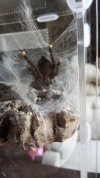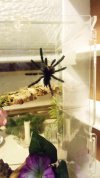Hi , new to owning a tarantula and I had some questions. I think she might be dehydrated but I'm not sure, anyway, I bought a Pink Toe in Dec, the first photo is when I bought her. The 2nd photo is this month, after she moulted for the first time in my care. One of my main questions is what should the humidity be..? Some seem to say it's not a big deal to keep up with/make sure that it stays within a bracket, while others are the total opposite lol. To keep her cage within the bracket, I would need to mist the substrate maybe 2 times a day, or if not that, once every day at the least. Does it need to always stay within that area at all times? Or is it ok that it dips back lower just as long as it's within what it should be once a day..? lol. Any help would be wonderful.
-
Are you a Tarantula hobbyist? If so, we invite you to join our community! Once you join you'll be able to post messages, upload pictures of your pets and enclosures and chat with other Tarantula enthusiasts. Sign up today!
You are using an out of date browser. It may not display this or other websites correctly.
You should upgrade or use an alternative browser.
You should upgrade or use an alternative browser.
New T owner - questions on some things
- Thread starter Miss Avah
- Start date
I fall in the camp of not chasing numbers. The care sheets often just use information based on areas of origin. In reality, most of what we buy are bred in someone’s home or warehouse far away from the “motherland.” Good ventilation is what is more important. Having water available along with a regular feeding schedule will take care of hydration. It’s perfectly normal for them to look a little haggard after a molt. It’s a lot of work on their part.
As far as I know, she hasn't ate anything since I bought her in Dec., but I'm really not sure. She is currently in the cage pictured here, but I did buy a REPTIZOO Glass Terrarium Tank that I want to switch her to soon. She does have a dish of water on the ground, which I have seen her at before.I fall in the camp of not chasing numbers. The care sheets often just use information based on areas of origin. In reality, most of what we buy are bred in someone’s home or warehouse far away from the “motherland.” Good ventilation is what is more important. Having water available along with a regular feeding schedule will take care of hydration. It’s perfectly normal for them to look a little haggard after a molt. It’s a lot of work on their part.
Attachments
- Messages
- 199
- Location
- Tacoma, Washington
I also don't worry about humidity unless it's my Theraphosa or more humidity sensitive T.
With arboreals I focus on the ventalation and ALL T's always have a water dish whether I see them use it or not.
With arboreals I focus on the ventalation and ALL T's always have a water dish whether I see them use it or not.
ok, well I did see her drinking from the dish before she went into molting but not after. I feel like her backside looks thin so that is why I'm wondering. Also since Pink Toes like being up high, should I just leave her water dish on the ground? or should it be up high?I also don't worry about humidity unless it's my Theraphosa or more humidity sensitive T.
With arboreals I focus on the ventalation and ALL T's always have a water dish whether I see them use it or not.
- Messages
- 199
- Location
- Tacoma, Washington
Her backside will be a bit thinner cause they are arboreal however after a molt especially thinner until they are able to eat their first meal.
- Messages
- 199
- Location
- Tacoma, Washington
Oop! I forgot to add some people will suction cup a water dish higher for ease of access but it's not really needed. On the ground is fine as well
Ok, I had heard that after their fangs turn black you can give them food. I looked the other day and hers looked black to me, so I did give her a meal worm in a dish on the ground close to where the water dish is. She either doesn't know it's down there yet, or she does and doesn't want it , lol.Her backside will be a bit thinner cause they are arboreal however after a molt especially thinner until they are able to eat their first meal.
- Messages
- 98
- Location
- Anywhere in North America.
A little basic tarantula anatomy and physiology: Almost all tarantulas are built almost like little, hermetically sealed bottles. Their exoskeletons are coated or infused with a waxy substance that prevents water escape. However, there are a few instances where that's not true. For instance, as a rule, tarantulas lose a little water vapor through the thin skinned, flexible joints on their legs.Hi , new to owning a tarantula and I had some questions. I think she might be dehydrated but I'm not sure, anyway, I bought a Pink Toe in Dec, the first photo is when I bought her. The 2nd photo is this month, after she moulted for the first time in my care. One of my main questions is what should the humidity be..? Some seem to say it's not a big deal to keep up with/make sure that it stays within a bracket, while others are the total opposite lol. To keep her cage within the bracket, I would need to mist the substrate maybe 2 times a day, or if not that, once every day at the least. Does it need to always stay within that area at all times? Or is it ok that it dips back lower just as long as it's within what it should be once a day..? lol. Any help would be wonderful.
----------------------------------------------------------------
NO! They're not leaking liquid water. At most its just an imperceptible amount of water vapor disappearing into our atmosphere. If you see liquid water at your little buddy's leg joint it means that it's been hurt and needs attention. That, however, is a topic for another thread.
----------------------------------------------------------------
And of course, some water is lost whenever they defecate (take a "dump," if you'll allow me to use a rather crude street term). And, they also probably lose more water than normal in the few hours to a few days following a molt. Lastly, female tarantulas that are laying eggs will lose a comparatively huge amount of water in the process because the eggs are suspended/immersed in a liquid "slurry" of water based body fluids with suspended particles and dissolved biological chemicals. The basic message here is that, with the exceptions of only a very few kinds, and a very slight "leakage" under certain circumstances, they're pretty much waterproof, inside and out!
Contrast that to humans (that would be us), who leak constantly, all over our bodies. Our skin is perforated with gazillions of little pores (our sweat glands) that evolved specifically to "leak like a sieve" as a temperature control mechanism. We are so ultra-sensitive to out-of-range body temperatures that we need this facility to allow evaporating water in our sweat to cool us. Since tarantulas are poikilotherms (cold blooded is the street term), they seldom have to worry about being too hot or too cold.
Now, considering that, since we know of about 1084 different species of tarantulas as of today (I just checked), with many more still to be discovered and named, there just has to be some variation in the rates of water loss between the different species. And, if you add in the fact that there are probably as great an individual variation between members of the same species as there is in humans, you begin to get the sense that we're not discussing so much a hard and fast rule as we are a gray blur with lots of dark and light areas.
Then, consider that the amount of water dissolved in the air surrounding your little buddy (relative humidity) varies pretty much chaotically, depending on all sorts of external influences on almost a moment by moment basis., often to an extreme extent. So, not only is it becoming more and more obvious that the topic of humidity and tarantulas is not only a gray blur, it's also a highly inconstant, "wriggly" gray blur, changing constantly and more or less erratically. Those light and dark blotches referred to above are always on the move!
----------------------------------------------------------------
Don't go looking for light and dark blotches moving around on your tarantula! That's just a figure of speech used to illustrate the point.
----------------------------------------------------------------
Now that I've opened your mind to all this, do you really think you should believe all those experts who write care sheets? Or espouse such profound numbers and limits so freely? (The topic of temperatures, BTW, is very much the same.)
To this end, I have put together a set of webpages, Myths, Misconceptions and Mistakes, to help you find your way through the morass of such delusions a little more easily. I urge you to read them all.
If you like what you read, you might go up that webtree a number of levels and explore the rest of the Spiders, Calgary webpage. If you don't, what could go wrong? (That's a grim joke!)
Be good to your newfound little buddy!
Stan


